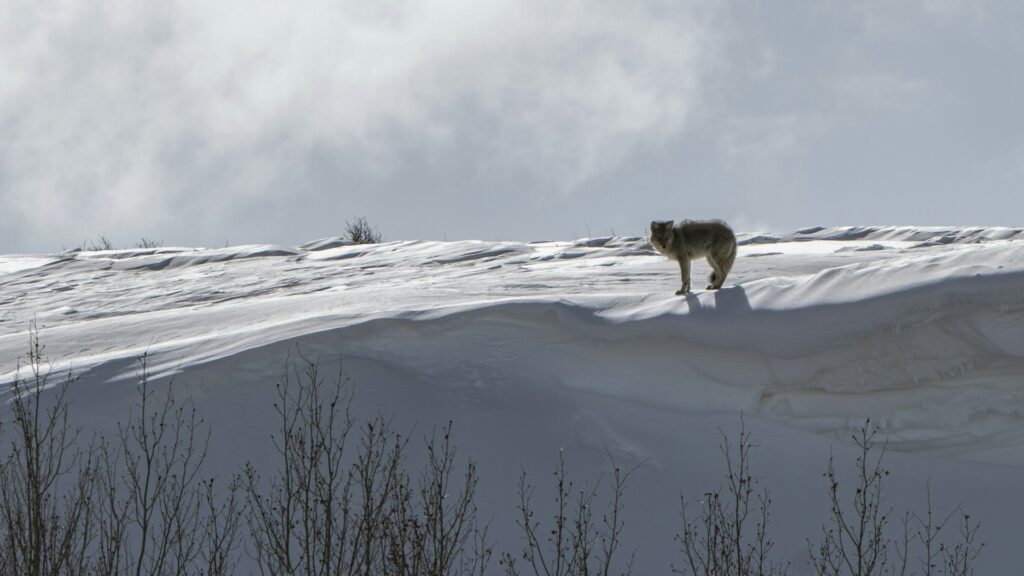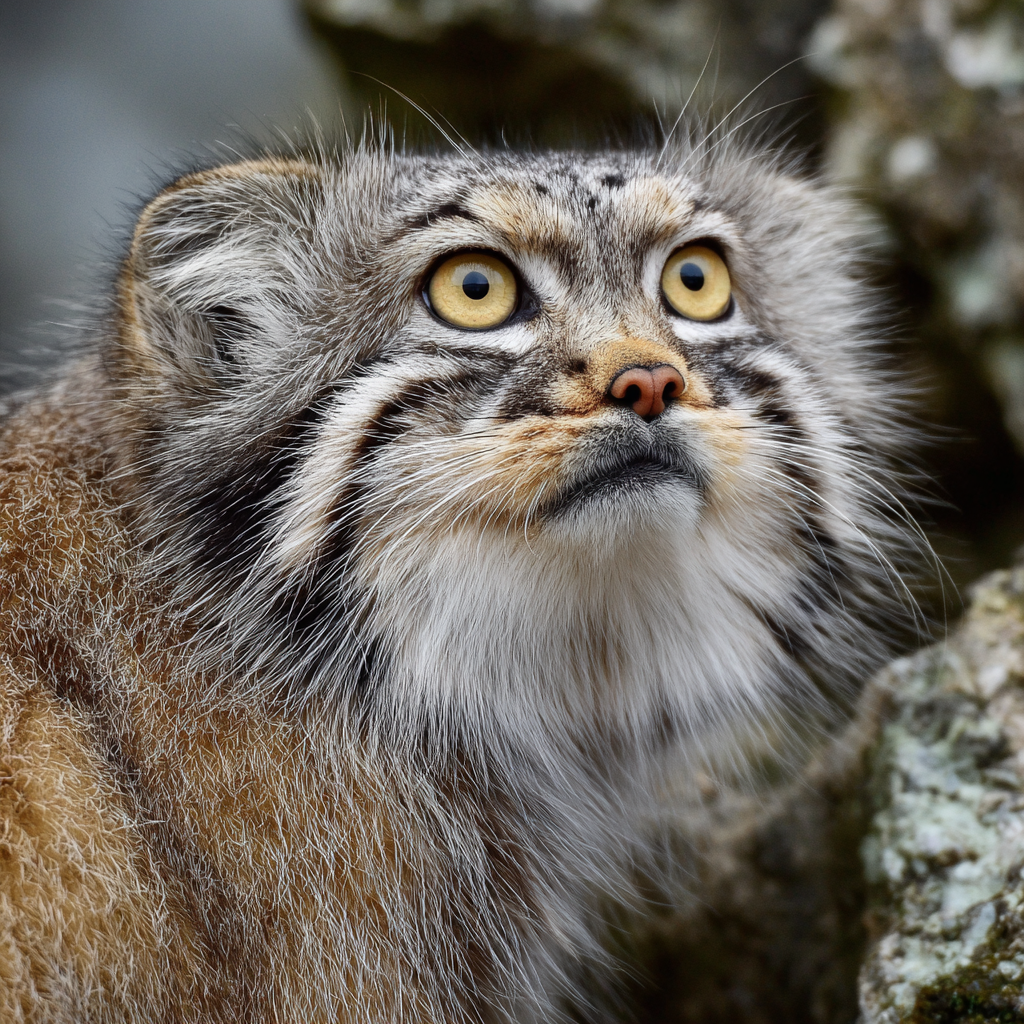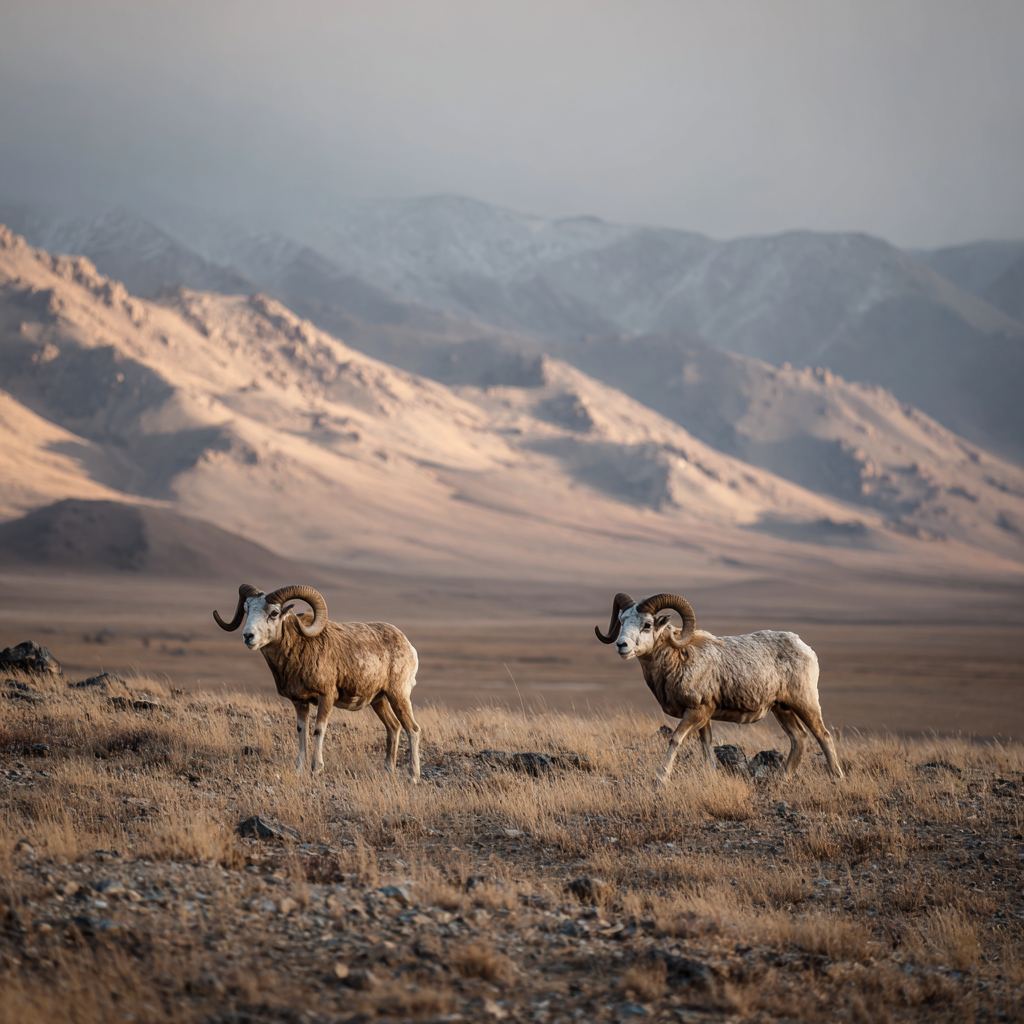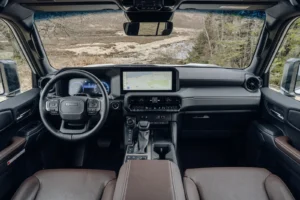Introduction: The Living Desert
Wildlife Spotting Gobi Desert Mongolia: When travelers hear the word Gobi Desert, many picture an endless emptiness of sand dunes stretching to the horizon. Yet, this stereotype could not be further from the truth. The Gobi Desert of Mongolia is one of the most diverse and wildlife-rich ecosystems on Earth. It is not a lifeless void, but a vast realm of steppes, rocky mountains, desert plains, oases, salt pans, and rolling dunes. This is the land where the wild Bactrian camel still roams, where the elusive snow leopard stalks ibex on jagged cliffs, and where thousands of Mongolian gazelles thunder across the grasslandsduring their seasonal migrations.
Stretching from the eastern steppe of Sukhbaatar province to the mountainous wilderness of Khovd province in the far west, the Gobi is more than just a desert — it is a living museum of evolutionary resilience. Animals here have adapted to survive in extreme conditions of scorching summers, freezing winters, and scarce water. For the wildlife traveler, the Gobi offers some of the world’s rarest wildlife encounters: spotting a critically endangered saiga antelope, watching a lammergeier (bearded vulture) drop bones from the sky, or tracking the footprints of a Gobi bear (Mazaalai) — a species with fewer than 50 individuals alive.

For those willing to journey far from paved roads, the Gobi becomes a wilderness safari unlike any other. Unlike the tightly managed national parks of Africa, the Gobi is a land of raw freedom. You will need a reliable 4×4 rental in Mongolia, such as the rugged Toyota Land Cruiser provided by Gobi.Rent, to explore the desert’s farthest corners. With a rooftop tent, GPS, and fuel reserves, you can drive yourself across this wild frontier and witness Mongolia’s wildlife in its natural habitat.
This comprehensive guide will take you province by province, from east to west, detailing which animals live where, how to spot them, the best seasons to visit, and the habitats to explore. It is not just a travel article — it is your field manual for wildlife spotting in the Gobi Desert.
By the end, you’ll understand why the Gobi is not a barren wasteland but one of the great last frontiers of wilderness travel on Earth.
Chapter 1: The Habitats of the Gobi Desert
Before diving into the specific provinces and animals, it is essential to understand the diverse habitats of the Gobi Desert. Unlike the sandy image most outsiders imagine, the Gobi is a patchwork of ecosystems. Each habitat supports a different set of species, and knowing these environments will help you understand where to search for the animals you seek.
1.1 The Eastern Steppe (Sukhbaatar & Dornogovi)
The eastern Gobi steppe is a vast, open landscape of grassland merging into semi-desert plains. This is the realm of the Mongolian gazelle, one of the largest remaining migratory herds of wild ungulates on Earth. Gazelles move in herds of tens of thousands, pursued by wolves and stalked by golden eagles. The eastern Gobi is also home to corsac foxes and a wide range of small rodents and birds of prey.
- Best time to visit: Spring and autumn, during gazelle migrations.
- Key animals: Mongolian gazelle, steppe wolf, corsac fox, saker falcon.
1.2 Semi-Desert Plains (Dundgovi & Ömnögovi)
As you travel westward, the grass becomes sparse, and rocky plains dominate the horizon. This is the semi-desert zone, where water becomes scarcer, and only the toughest animals survive. Wolves still roam here, and raptors such as steppe eagles and golden eagles patrol the skies. In these landscapes, you can also encounter the rare Pallas’s cat (Manul) — an elusive wildcat perfectly adapted to rocky burrows.
- Best time to visit: Autumn and spring.
- Key animals: Wolves, Pallas’s cat, steppe eagle, golden eagle.

1.3 The True Desert (Ömnögovi)
At the heart of the Gobi lies the true desert, with giant sand dunes, gravel plains, and salt pans. This harsh environment is home to the Gobi bear (Mazaalai) and the wild Bactrian camel, two of the rarest large mammals on Earth. To see them, you must travel into the Great Gobi Strictly Protected Area, one of the least disturbed deserts on the planet.
- Best time to visit: Summer for bears, spring/autumn for camels.
- Key animals: Gobi bear, wild Bactrian camel, desert reptiles.
1.4 Mountain Habitats (Ömnögovi, Govi-Altai, Khovd)
Rising suddenly from the plains are rugged mountain ranges such as the Tost Mountains and the Altai range. These cliffs and ridges are the stronghold of snow leopards, Siberian ibex, and argali sheep. The vertical terrain offers both prey and predator sanctuary. Raptors such as the lammergeier are also common here.
- Best time to visit: Winter and early spring for snow leopards; year-round for ibex and argali.
- Key animals: Snow leopard, Siberian ibex, argali sheep, lammergeier.
1.5 Lakes and Oases (Bayankhongor, Khovd)
Although the Gobi is dry, there are scattered lakes and rivers, particularly in its western reaches. Orog Lake, Taatsiin Tsagaan Lake, and Khar Us Lake are magnets for migratory birds. Cranes, geese, ducks, and even rare bustards gather here, making these wetlands critical birdwatching destinations.
- Best time to visit: May–June for nesting, August–September for migration.
- Key animals: Migratory cranes, geese, ducks, sandgrouse, Houbara bustard.
Summary of Chapter 1:
The Gobi Desert is not one landscape but many: open steppe, semi-desert plains, true desert, rugged mountains, and seasonal wetlands. Each provides a unique habitat, and each will feature prominently in the wildlife chapters ahead. Understanding these zones will allow you to plan your journey strategically, ensuring the best chance of spotting the rare animals of Mongolia’s Gobi Desert.
Chapter 2: Eastern Gobi Wildlife – Sukhbaatar & Dornogovi
The Eastern Gobi Desert, spanning Sukhbaatar province and Dornogovi province, is one of the most dynamic wildlife zones in Mongolia. Unlike the barren stereotype of deserts, this region is an expansive steppe-meets-desert ecosystem. Here, wide-open plains stretch to the horizon, dotted with shrubs and dry grasses, creating perfect grazing grounds for Mongolian gazelles. The Eastern Gobi is also an important hunting ground for wolves, raptors, and corsac foxes.
For wildlife travelers, the east offers some of the most accessible wildlife spotting in Mongolia, thanks to the sheer numbers of animals, especially the iconic Mongolian gazelle herds.
2.1 The Mongolian Gazelle (Procapra gutturosa)
Where to See Them
The Mongolian gazelle is the star of the Eastern Gobi. Herds can number in the tens of thousands, making them one of the last great migratory ungulates left in Asia. You’ll find them primarily in Sukhbaatar province, moving west into Dornogovi depending on grass availability.
When to Spot Them
- Spring (April–June): Calving season, when females gather in large groups.
- Autumn (Sept–Oct): Migration peaks, creating massive moving herds.
- Best Times of Day: Dawn and dusk, when gazelles graze actively.
How to Spot Them
Look for dust clouds on the horizon — a telltale sign of herds on the move. A pair of binoculars is essential, as gazelles are skittish and will keep distance from vehicles. In early morning light, their tan coats blend with the grasslands, so patience and scanning are key.
Fun Fact
Mongolian gazelles can run up to 65 km/h, and when startled, entire herds gallop together in spectacular unison.
Read this if you are interested in: Mongolian gazelle migration, Sukhbaatar gazelles, Dornogovi gazelle herds, gazelle watching Mongolia.
2.2 Corsac Fox (Vulpes corsac)
Where to See Them
The corsac fox thrives in the semi-desert plains of Dornogovi and open grasslands of Sukhbaatar. Unlike the red fox, corsacs are smaller, with pale sandy fur perfectly camouflaged against the Gobi steppe.
When to Spot Them
- Best Season: Autumn and winter, when coats grow thick and pale.
- Best Time of Day: Dawn and dusk, when foxes hunt for rodents and hares.
How to Spot Them
Look near rodent colonies, particularly marmot or gerbil burrows. Foxes are often spotted trotting across open plains. Use binoculars to catch them as they sit upright scanning the horizon.
Behavior
Corsac foxes are opportunistic hunters, often following herds to scavenge. At night, they emit high-pitched barks that carry across the steppe.
Read this if you are interested in: corsac fox Mongolia, foxes in Dornogovi, Gobi Desert fox, wildlife in eastern Gobi.
2.3 The Steppe Wolf
Where to See Them
The steppe wolf follows gazelle herds across Sukhbaatar province. These wolves are larger than corsac foxes and are apex predators in the Eastern Gobi ecosystem.
When to Spot Them
- Best Season: Year-round, but especially spring and autumn during gazelle migrations.
- Best Time of Day: Dawn, when wolves patrol the edges of herds.
How to Spot Them
Scan areas where gazelle herds are resting. Wolves are skilled at using terrain for cover, so look for movement near small rises or dry riverbeds. Tracks and scat are often found near watering holes.
Behavior
Wolves hunt in packs and can bring down adult gazelles. They are also scavengers, feeding on carcasses left behind by eagles or foxes.
Read this if you are interested in: steppe wolf Mongolia, wolves in Sukhbaatar, Gobi Desert predators, wolf spotting Mongolia.
2.4 Raptors of the Eastern Gobi
The skies above Sukhbaatar and Dornogovi are patrolled by raptors, making this region a paradise for bird enthusiasts.
Steppe Eagle (Aquila nipalensis)
- Where: Open plains, nesting on the ground or low cliffs.
- When: Spring and autumn migrations.
- How to Spot: Circling on thermals at midday, scanning for rodents.
Saker Falcon (Falco cherrug)
- Where: Dornogovi cliffs and semi-desert plains.
- Status: National bird of Mongolia, highly prized in falconry.
- How to Spot: Fast-flying falcon hunting ground squirrels and pigeons.
Golden Eagle (Aquila chrysaetos)
- Where: Cliff ranges and hilly zones in Sukhbaatar.
- How to Spot: Huge wingspan, soaring in pairs.
Read this if you are interested in: raptors in Gobi Desert, steppe eagle Mongolia, saker falcon spotting, Dornogovi birdwatching.
2.5 Small Mammals & Steppe Rodents
The Eastern Gobi steppe is alive with small mammals. While less glamorous, they form the base of the food chain.
- Marmots: Though more common in northern steppes, colonies exist in Sukhbaatar. Look for burrow mounds.
- Gerbils & Jerboas: Nocturnal rodents seen at night with a torch.
- Tolai Hare: Pale desert hare, often flushed from shrubs.
These small creatures attract foxes, wolves, and raptors, making them essential for spotting larger predators.
Read this if you are interested in: rodents in Gobi Desert, jerboa Mongolia, marmots Sukhbaatar, steppe wildlife Mongolia.
Tips for Wildlife Spotting in Eastern Gobi
- Best Provinces: Sukhbaatar for gazelles, Dornogovi for raptors and foxes.
- Best Season: April–June and September–October.
- Best Gear: Binoculars, spotting scope, and GPS navigation.
- Best Vehicle: Rent a 4×4 from Gobi.Rent — eastern tracks can be sandy and remote.
- Camping Tip: Stay near dry riverbeds for nighttime fox calls and dawn birdwatching.
Why the Eastern Gobi Matters
The Eastern Gobi steppe is one of the last places on Earth where massive ungulate migrations still occur. The Mongolian gazelle herds rival Africa’s wildebeest migrations, yet far fewer travelers witness them. Protecting this ecosystem is vital, not only for gazelles but for wolves, raptors, and foxes that depend on them.
For travelers, the east is an ideal starting point for a Gobi Desert wildlife safari. From here, journeys can continue west into the central desert, where the landscapes — and the wildlife — become even more dramatic.
Chapter 3: Central Gobi Wildlife – Dundgovi & Ömnögovi
When travelers think of the Gobi Desert, they usually imagine the heart of the desert — the vast expanses of Dundgovi province and the legendary dunes and mountains of Ömnögovi province. This is the core Gobi, a place of iconic landscapes: towering sand dunes, rocky canyons, hidden oases, and sacred mountains.
But beyond its scenery, the Central Gobi is home to some of the world’s rarest and most endangered species. This region shelters the Gobi bear (Mazaalai), the elusive wild Bactrian camel, herds of argali sheep and ibex, and predators like the snow leopard. For wildlife travelers, Dundgovi and Ömnögovi are the jewel of the Gobi Desert safari.
3.1 Gobi Bear (Mazaalai)
Status
- Fewer than 60 individuals remain, making the Gobi bear one of the rarest animals on Earth.
- Critically endangered and found only in Mongolia.
Where to See Them
The Gobi bear lives in the Great Gobi Strictly Protected Area A, mostly in Ömnögovi province. Their habitat is the oases and desert springs scattered across this remote desert.
When to Spot Them
- Best Season: Summer (July–August), when they come to water sources.
- Time of Day: Early morning and dusk, when temperatures are cooler.
How to Spot Them
Spotting a Mazaalai requires patience and often the help of local rangers. They frequent areas near waterholes such as Ekhiin Gol oasis. Look for tracks in the sand and claw marks on rocky outcrops.
Read this if you are interested in: Gobi bear, Mazaalai Mongolia, rarest bear species, Gobi Desert endangered animals.
3.2 Wild Bactrian Camel (Camelus ferus)
Status
- Fewer than 1,000 wild camels survive in the Gobi, making them critically endangered.
- Different from domestic camels: slimmer build, smaller humps, and remarkable adaptations to saltwater.
Where to See Them
Wild camels roam the Gobi desert steppe of Ömnögovi and parts of Dundgovi, often near dry riverbeds and salt springs.
When to Spot Them
- Best Season: Autumn (Sept–Oct), during migrations between pastures.
- Best Time: Early mornings, as they graze in small herds.
How to Spot Them
They are extremely wary of humans. Use binoculars to scan for movement at the base of sand dunes or along dry valleys. Unlike domestic herds, wild camels keep their distance and move quickly away from vehicles.
Read this if you are interested in: wild Bactrian camel Mongolia, Ömnögovi wildlife, endangered camels Gobi Desert.
3.3 Argali Sheep & Siberian Ibex
The mountain ridges of Dundgovi and Ömnögovi host two of Mongolia’s most iconic ungulates:
- Argali Sheep (Ovis ammon): The world’s largest wild sheep, with massive spiraled horns.
- Siberian Ibex (Capra sibirica): Agile climbers, often found on cliffs and rocky gorges.
Where to See Them
- Argali sheep are best spotted in the Ikh Bogd mountains of Dundgovi.
- Ibex are common in Yolyn Am gorge and the cliffs of the Three Beauties Mountains (Gurvan Saikhan National Park) in Ömnögovi.
Best Season & Time
- Spring & Autumn: Mating seasons increase visibility.
- Dawn: Herds descend to graze.
How to Spot Them
Use spotting scopes to scan cliffsides at sunrise. Argali rams stand out by their massive horns, while ibex move in herds across steep terrain.
Read this if you are interested in: argali sheep Mongolia, ibex in Gobi Desert, Dundgovi mountain wildlife, Gurvan Saikhan National Park animals.
3.4 Snow Leopard (Panthera uncia)
The ghost of the mountains, the snow leopard, roams the high ridges of the Central Gobi mountains. While sightings are incredibly rare, knowing they share the landscape makes the region feel magical.

Where to See Them
- Gurvan Saikhan Mountains, Ömnögovi
- Ikh Bogd range, Dundgovi
Best Season & Time
- Winter (Nov–Feb): Snow leopards descend to lower altitudes following ibex and argali.
- Dawn & Dusk: Prime hunting hours.
How to Spot Them
Spotting snow leopards in the wild requires joining conservation-led tracking tours. Look for fresh scat, paw prints in snow, or the alarm calls of ibex.
Read this if you are interested in: snow leopard Mongolia, snow leopard in Gobi Desert, Central Gobi predators, wildlife tracking Mongolia.
3.5 Raptors & Birds
The cliffs and valleys of Central Gobi are prime habitats for raptors and rare desert birds.
- Lammergeier (Bearded Vulture): Seen soaring in Yolyn Am gorge. Famous for bone-dropping behavior.
- Steppe Eagle & Golden Eagle: Patrol the open valleys.
- Desert Finch & Saxaul Sparrow: Small birds adapted to desert shrubs.
- Houbara Bustard: Rare ground bird, spotted in remote steppe zones.
Read this if you are interested in: birdwatching in Gobi Desert, Lammergeier Mongolia, Gurvan Saikhan birds, Ömnögovi bird species.
3.6 Other Mammals of Central Gobi
- Red Fox & Corsac Fox: Common across steppe regions.
- Pallas’s Cat (Manul): Elusive wildcat found in rocky habitats. Best seen at dawn.
- Wolves: Predators that follow gazelles and argali herds.
These smaller predators make the ecosystem balanced, feeding on rodents and scavenging from larger kills.

Read this if you are interested in: wolves in Ömnögovi, Pallas’s cat Gobi, fox species Mongolia.
Tips for Wildlife Spotting in Central Gobi
- Best Provinces: Ömnögovi (Gurvan Saikhan, Yolyn Am, Khongoryn Els dunes), Dundgovi (Ikh Bogd mountains).
- Best Seasons: Summer for Gobi bears, autumn for camels, winter for snow leopards.
- Best Gear: Spotting scope, long-lens camera, GPS, desert survival kit.
- Best Vehicle: A Toyota Land Cruiser 78 or 79 rented from Gobi.Rent, equipped for rough desert roads.
- Camping Tip: Stay near natural springs and canyons — they attract wildlife at dawn and dusk.
Why Central Gobi Matters
The Central Gobi Desert is the heart of Mongolia’s wilderness. It protects some of the rarest animals alive today, including the critically endangered Gobi bear and wild Bactrian camel. Without this desert, these species would vanish forever.
For travelers, the Central Gobi offers a once-in-a-lifetime safari experience — spotting wild camels walking across dunes, ibex perched on cliffs, and maybe, just maybe, the shadow of a snow leopard.
Chapter 4: Western Gobi Wildlife – Bayankhongor, Govi-Altai & Khovd
The western Gobi Desert is where the rolling plains of Mongolia merge with the Altai mountain system. This creates a spectacular mix of habitats: deserts, semi-desert steppes, rugged cliffs, alpine zones, salt lakes, and river valleys. These landscapes harbor a variety of mountain-adapted species — from the saiga antelope of Shargiin Gobi to the argali sheep and ibex of rocky slopes, to soaring lammergeiers in the high cliffs.
The western provinces — Bayankhongor, Govi-Altai, and Khovd — are the most remote sections of the Gobi Desert. Wildlife here is elusive but rewarding for patient travelers who venture with the right gear and vehicles.
4.1 Saiga Antelope (Saiga tatarica mongolica)
Status
- Critically endangered. The Mongolian subspecies has declined drastically due to poaching and habitat loss.
- Famous for their bulbous nose, which filters dust in summer and warms air in winter.
Where to See Them
- Shargiin Gobi, Khovd province.
- Open steppe zones with sparse vegetation.
Best Season & Time
- Winter (Nov–Feb): Tracks are more visible in snow.
- Early Morning: Herds graze openly.
How to Spot Them
Join ranger-led tours around Shargiin Gobi. Look for trails in the snow or dust and scanning with binoculars from a distance. Saiga are extremely shy and sprint away quickly when disturbed.
Read this if you are interested in: saiga antelope Mongolia, Shargiin Gobi wildlife, endangered antelope Gobi Desert.
4.2 Siberian Ibex & Argali Sheep
Two iconic ungulates thrive in the rocky ridges of the Altai-influenced western Gobi.
- Siberian Ibex (Capra sibirica): Recognizable by their long, curved horns.
- Argali Sheep (Ovis ammon): The world’s largest wild sheep, with horns weighing up to 20 kg.

Where to See Them
- Mountains of Govi-Altai and Khovd provinces.
- Cliffs and steep slopes near alpine meadows.
Best Season & Time
- Spring & Autumn: Herds gather in visible groups.
- Sunrise: Best chance, as they descend to feed.
How to Spot Them
Use spotting scopes to watch from a distance. Look for movement high on cliffs. Often ibex are seen in herds, while male argali can be spotted in bachelor groups.
Read this if you are interested in: argali sheep Gobi Altai, Siberian ibex Mongolia, mountain wildlife Khovd, Govi-Altai animals.
4.3 Lammergeier (Bearded Vulture)
The lammergeier, or bearded vulture, is one of the most dramatic birds of the Gobi-Altai cliffs.
Where to See Them
- Cliffs and gorges of Govi-Altai province.
- Often near argali and ibex ranges, where they scavenge bones.
Unique Behavior
- Famous for carrying bones high into the air and dropping them onto rocks to crack them open.
- Feeds almost entirely on bone marrow.
Best Season & Time
- Year-round resident in the Altai ranges.
- Best spotted at midday, soaring in thermals.
Read this if you are interested in: lammergeier Mongolia, bearded vulture Gobi Altai, raptors of the Gobi Desert.
4.4 Other Mammals of the Western Gobi
- Wolves (Canis lupus): Common in Bayankhongor province, hunting gazelles and livestock. Best seen in early morning on open steppe.
- Pallas’s Cat (Manul): Elusive wildcat of rocky steppe habitats in Khovd. Best spotted at dawn or dusk.
- Corsac Fox: A small desert fox active in twilight, often near saiga ranges.
Read this if you are interested in: wolves in Bayankhongor, Pallas’s cat Mongolia, Corsac fox Gobi Desert.
4.5 Rare & Migratory Birds
Western Gobi lakes and valleys are important stopovers for migratory birds.
- Cranes (Demoiselle & Siberian Cranes): Seen at Khar Us Lake and Orog Lake.
- Saker Falcon (Falco cherrug): Mongolia’s national bird, often spotted hunting across steppes.
- Steppe Eagle & Golden Eagle: Regular in Govi-Altai.
Read this if you are interested in: birdwatching Khovd Mongolia, cranes in Gobi Desert, Saker Falcon Mongolia, Orog Lake birds.
4.6 Seasonal Patterns in Western Gobi
- Winter: Best time for saiga spotting. Snow makes tracking easier.
- Spring: Raptors nesting in cliffs, ibex active.
- Summer: Wolves near water sources; Pallas’s cat sometimes spotted.
- Autumn: Argali rams engage in head-butting contests.
Tips for Wildlife Spotting in Western Gobi
- Provinces to Visit:
- Bayankhongor: Wolves, migratory birds at Orog Lake.
- Govi-Altai: Ibex, argali, lammergeiers in rocky mountains.
- Khovd: Saiga antelope in Shargiin Gobi, Pallas’s cat in steppe.
- Travel Style:
- Use a Toyota Land Cruiser 79 with rooftop tent from Gobi.Rent.
- Western Gobi roads are extremely rough — self-drive safaris need well-equipped vehicles.
- Best Seasons:
- Winter for saiga, snow leopards lower down.
- Spring for ibex and argali.
- Spotting Techniques:
- Always carry binoculars and a spotting scope.
- Scan ridge lines at dawn.
- Stay quiet and observe from afar to avoid scaring animals.
Why the Western Gobi is Special
The Western Gobi blends desert wilderness with Altai mountain ecosystems, creating a stronghold for critically endangered animals like the saiga antelope and rare predators like the Pallas’s cat.
For wildlife travelers, this is one of the last true frontiers of nature — remote, wild, and breathtaking. Few travelers make it here, but those who do witness a side of Mongolia that feels untouched by time.
Chapter 5: Birds of the Gobi – An Underrated Paradise for Birdwatching
The Gobi Desert may seem barren at first glance, but it is in fact one of the most underrated birdwatching destinations in Asia. Its unique ecosystems — rocky gorges, saxaul forests, sand dunes, steppe lakes, and desert oases — attract over 200 bird species, including migratory wonders, raptors, and desert specialists found nowhere else in the world.
For birdwatchers and wildlife travelers, the Gobi offers the chance to see lammergeiers dropping bones, cranes dancing by desert lakes, and falcons hunting over endless steppe. Whether you are in Sukhbaatar in the east or Khovd in the west, each province of the Gobi Desert provides different avian highlights.
5.1 Lammergeier (Bearded Vulture)
- Where: Common in the cliffs of Govi-Altai, Ömnögovi, and Dundgovi provinces.
- Behavior: Famous for dropping bones from the sky to break them open and eat the marrow.
- Best Time: Midday, when thermals allow soaring flight.
- Habitat: High cliffs and mountain valleys.
Read this if you are interested in: lammergeier Mongolia, bearded vulture Gobi Desert, raptors of Mongolia.
5.2 Golden Eagle & Steppe Eagle
Golden Eagle (Aquila chrysaetos)
- Symbol of strength, used in traditional Kazakh eagle hunting in western Mongolia.
- Where: Cliffs and ridges across the Gobi Altai.
- When: Year-round, especially visible in winter.
Steppe Eagle (Aquila nipalensis)
- Migratory raptor traveling thousands of kilometers between Mongolia and Africa.
- Where: Open steppe zones in Dornogovi, Dundgovi, and Ömnögovi provinces.
- When: Spring and autumn migrations (April–May, Sept–Oct).
Read this if you are interested in: golden eagle Gobi, steppe eagle migration Mongolia, raptors in Gobi Desert.
5.3 Saker Falcon – Mongolia’s National Bird
- Status: Endangered due to habitat loss and trapping.
- Where: Steppes and semi-desert zones of Dornogovi and Ömnögovi provinces.
- Behavior: Hunts pigeons, ground squirrels, and small birds in fast aerial dives.
- Best Season: Spring and summer (April–July), during breeding season.
Read this if you are interested in: Saker Falcon Mongolia, national bird of Mongolia, falcons of Gobi Desert.
5.4 Houbara Bustard (Chlamydotis undulata)
- Where: Remote desert steppe habitats of Ömnögovi and Govi-Altai.
- Status: Threatened by hunting and falconry across its range.
- Behavior: Ground-dwelling bird with elaborate courtship dances.
- Best Time: Spring (March–May), when males display.
Read this if you are interested in: Houbara Bustard Mongolia, rare desert birds, bustards Gobi Desert.
5.5 Sandgrouse
Several species of sandgrouse inhabit the Gobi Desert, perfectly adapted to dry conditions.
- Pallas’s Sandgrouse (Syrrhaptes paradoxus): Famous for carrying water in their belly feathers to chicks.
- Where: Open desert plains in Dornogovi and Dundgovi provinces.
- Best Time: Morning, when they fly in flocks to waterholes.
Read this if you are interested in: Pallas’s sandgrouse Mongolia, desert birds Gobi, sandgrouse water-carrying behavior.
5.6 Cranes of the Gobi
Cranes are among the most spectacular migratory birds of Mongolia, and several species use the Gobi’s lakes as stopovers.
- Demoiselle Crane: Common at lakes like Orog Lake (Bayankhongor) and Khar Us Lake (Khovd).
- White-Naped Crane: Threatened species, spotted in wetlands.
- Siberian Crane: One of the rarest cranes, occasionally sighted during migrations.
Best Seasons:
- May–June: Northward migration.
- August–September: Southward migration.
Read this if you are interested in: cranes in Mongolia, Demoiselle crane Gobi Desert, Orog Lake birdwatching.
5.7 Migratory Stopovers – Desert Lakes & Wetlands
Although the Gobi is arid, its lakes and wetlands are biodiversity hotspots.
- Orog Lake (Bayankhongor): Migratory stopover for cranes, geese, and shorebirds.
- Khar Us Lake (Khovd): UNESCO Biosphere Reserve, hosting pelicans, ducks, and eagles.
- Boon Tsagaan Lake (Bayankhongor): Important for swans and migratory ducks.
These lakes become alive with bird activity in spring and autumn, making them must-visit spots for birdwatchers.
Read this if you are interested in: birdwatching Orog Lake, migratory birds Khar Us Lake, wetlands in Gobi Desert.
5.8 Small Desert Birds
While raptors and cranes steal the spotlight, the smaller resident birds of the Gobi are equally fascinating.
- Saxaul Sparrow: Associated with saxaul forests in Dornogovi and Ömnögovi.
- Mongolian Ground Jay: Unique desert bird found in the central and western Gobi.
- Horned Lark: Widespread, often seen foraging in sandy valleys.
Read this if you are interested in: Saxaul Sparrow Mongolia, Mongolian Ground Jay, small desert birds Gobi.
5.9 Best Times for Birdwatching in the Gobi
- Spring (April–June): Bird nesting, raptor activity, crane migrations.
- Summer (July–August): Resident species active near waterholes.
- Autumn (Sept–Oct): Major southward migration of cranes, bustards, and raptors.
- Winter (Nov–Feb): Raptors like golden eagles and lammergeiers visible in snow landscapes.
Best Time of Day:
- Dawn: Birds emerge from roosts, raptors start hunting.
- Dusk: Sandgrouse and cranes return to water sources.
Why the Gobi is a Birdwatcher’s Dream
Despite its reputation as a “lifeless desert,” the Gobi is alive with avian biodiversity. From the bone-breaking lammergeier to the water-carrying sandgrouse, the Gobi’s birds showcase some of the most unique adaptations in the animal kingdom.
For travelers, birdwatching in the Gobi is about patience and discovery. A quiet morning at a desert lake or a hike through a rocky gorge can reveal rare and unforgettable sightings. With the freedom of a self-drive safari vehicle from Gobi.Rent, birdwatchers can reach remote hotspots across all provinces of the desert.
Chapter 6: When and How to Spot Wildlife in the Gobi Desert
The Gobi Desert rewards patience, knowledge, and timing. Understanding when and how to spot wildlife makes the difference between a fleeting glimpse and an unforgettable encounter. Each season and each time of day reveals different species and behaviors.
Wildlife by Season in the Gobi Desert
Spring (April–June):
Spring is one of the best times to visit the Gobi Desert for wildlife spotting. Mongolian gazelle herds begin their migrations across Dornogovi and Sukhbaatar. This is also the season for bird nesting, with Houbara bustards displaying and cranes arriving at lakes like Orog and Boon Tsagaan. Mountain goats such as Siberian ibex are particularly active as they feed on fresh vegetation in Govi-Altai cliffs.
Summer (July–August):
Summer brings challenges with heat, but also rare opportunities. The endangered Gobi bear, or Mazaalai, can sometimes be seen near scarce water sources in Ömnögovi. Waterfowl concentrate around lakes in Bayankhongor and Khovd. Early mornings and late evenings are essential during this season, as midday heat keeps animals in shade.
Autumn (September–October):
Autumn is a prime time for spotting wild Bactrian camels and kulan (wild asses) in the Ömnögovi reserves. Migratory birds gather at lakes in Khovd and Zavkhan on their journey south. Predators like wolves and snow leopards increase activity as they prepare for winter, making tracking easier for keen observers.
Winter (November–February):
Though harsh, winter reveals some of the rarest sights in the Gobi Desert. Snow leopards descend to lower elevations in Bayankhongor and Govi-Altai. Saiga antelope in Khovd become easier to track in snow. Foxes and wolves leave clear trails. For serious wildlife photographers, winter is unmatched in drama and beauty.
Wildlife by Time of Day in the Gobi Desert
- Dawn (5–8 am): Herds of gazelles, wild asses, and camels graze openly. Predators like wolves are still active. Raptors begin to soar on the first thermals.
- Daytime (10 am–4 pm): Most animals shelter from the sun. Best for birdwatching at lakes and spotting reptiles.
- Dusk (5–8 pm): Raptors hunt, foxes emerge, and herbivores graze again. Twilight is one of the best times to spot ibex and argali on mountain slopes.
- Night (8 pm–4 am): With proper equipment, nocturnal animals like jerboas, Pallas’s cats, and nightjars can be observed. Some travelers bring thermal scopes for ethical nighttime wildlife spotting.
Chapter 7: Responsible Wildlife Watching in the Gobi Desert
The Gobi is fragile. Many species are endangered and sensitive to disturbance. Responsible behavior ensures that travelers protect what they came to see.
Key Guidelines for Ethical Gobi Wildlife Spotting
- Keep Your Distance:
Stay at least 300–500 meters from large mammals like camels, gazelles, and saiga. Use binoculars or spotting scopes instead of approaching. - Never Feed Animals:
Feeding alters natural behavior and can harm wildlife. Even offering water to gazelles or camels disrupts their survival instincts. - Respect Nesting Sites:
Birds such as the Houbara bustard and cranes are sensitive to disturbance during breeding. Avoid loud noise or approaching nests. - Travel with Rangers When Possible:
Local rangers in Ömnögovi and Khovd monitor endangered species like wild camels and saiga antelope. Joining ranger-led tours supports conservation and increases your spotting chances. - Support Conservation Projects:
Organizations like the Snow Leopard Trust, Saiga Monitoring Programs, and the Mazaalai Bear Conservation Project rely on funding and data from visitors. Donations or volunteering make a lasting impact. - Leave No Trace:
Pack out all waste. Avoid off-road driving in fragile steppe and dune habitats unless on marked tracks.
Responsible tourism ensures that future generations will continue to marvel at the rare and resilient wildlife of the Gobi Desert.
Chapter 8: Planning Your Self-Drive Gobi Wildlife Safari
The Gobi Desert is vast. Public transport barely touches its edges, and tours often follow fixed routes. For true freedom and the best wildlife encounters, a self-drive safari with a reliable 4×4 vehicle from Gobi.Rent is the best choice.
Why Rent a Toyota Land Cruiser or Similar 4×4?
- The Gobi’s terrain ranges from rocky canyons to endless sand tracks.
- A Land Cruiser 76 or 78 with rooftop tent provides both mobility and shelter.
- Extra fuel tanks and water storage are essential for long stretches without services.
- High clearance and durability make Land Cruisers the top choice for Mongolian expeditions.
Suggested Routes for Wildlife Spotting in the Gobi Desert
1. East Gobi Gazelle Trail (7–10 days)
Route: Sukhbaatar → Dornogovi → Ikh Nart Nature Reserve
Highlights: Mongolian gazelle herds, steppe raptors, desert gerbils, sunrise over endless plains.
2. Central Gobi Expedition (10–14 days)
Route: Ömnögovi → Bayanzag → Yolyn Am → Great Gobi Strictly Protected Area
Highlights: Wild camels, Gobi bears, Pallas’s cat, bearded vultures.
3. West Gobi Altai Loop (14–21 days)
Route: Bayankhongor → Govi-Altai → Khovd → Shargiin Gobi → Altai Mountains
Highlights: Saiga antelope, argali sheep, snow leopards, Siberian ibex, cranes at Khar Us Lake.
Essential Gear for a Wildlife Safari in the Gobi
- Binoculars (8×42 recommended)
- Spotting scope for distant mountains
- DSLR or mirrorless camera with telephoto lens
- Thermal clothing for desert nights
- Satellite GPS and maps
- Rooftop tent with insulation
- Cooking kit and water purification system
- Field guides for mammals and birds of Mongolia
Conclusion: Wildlife Spotting Gobi Desert Mongolia
The Gobi Desert is not empty. From east to west, across Sukhbaatar, Dornogovi, Dundgovi, Ömnögovi, Bayankhongor, Govi-Altai, and Khovd, it pulses with life. Gazelles thunder across open plains. Wild camels roam silent dunes. Saiga antelope dash across snow in winter. Snow leopards stalk ibex in the shadow of the Altai. Cranes dance in shimmering wetlands.
Every province has its treasures, and every traveler who ventures deep into the desert with respect and patience is rewarded.
A self-drive journey with Gobi.Rent gives you freedom, safety, and access to Mongolia’s rarest wildlife. The desert will test you, but it will also reveal one of the most spectacular living landscapes on Earth.
Read this if you are interested in
Animals
- Mongolian gazelle
- Wild Bactrian camel
- Gobi bear (Mazaalai)
- Saiga antelope (Mongolian saiga)
- Kulan (Asiatic wild ass)
- Snow leopard Mongolia
- Pallas’s cat (Manul)
- Argali sheep
- Siberian ibex
- Lammergeier (Bearded vulture)
- Golden eagle Mongolia
- Steppe eagle Gobi
- Saker falcon Mongolia
- Houbara bustard
- Sandgrouse Mongolia
- Demoiselle crane
- Wolves in Mongolia
- Jerboa desert rodent
Province + Wildlife Spotting
- Sukhbaatar gazelle herds
- Dornogovi wildlife
- Dundgovi birdwatching
- Ömnögovi wild camel
- Bayankhongor Gobi bear
- Govi-Altai ibex and argali
- Khovd saiga antelope
- Altai Mountains snow leopard
- Orog Lake migratory birds
- Khar Us Lake birdwatching
General topics regarding wildlife spotting in Mongolia
- Gobi Desert wildlife spotting
- Best time to see wildlife in Gobi Desert
- Gobi Desert animals list
- Mongolia self-drive safari
- Rent a Land Cruiser Mongolia
- Gobi.Rent 4×4 rental
- Wildlife photography Gobi Desert
- Birdwatching Gobi Desert
- Endangered species in Mongolia
- Gobi Desert eco travel






